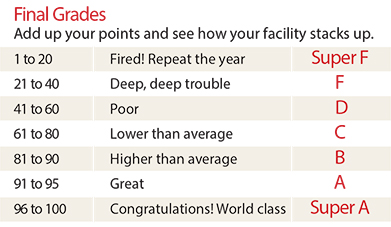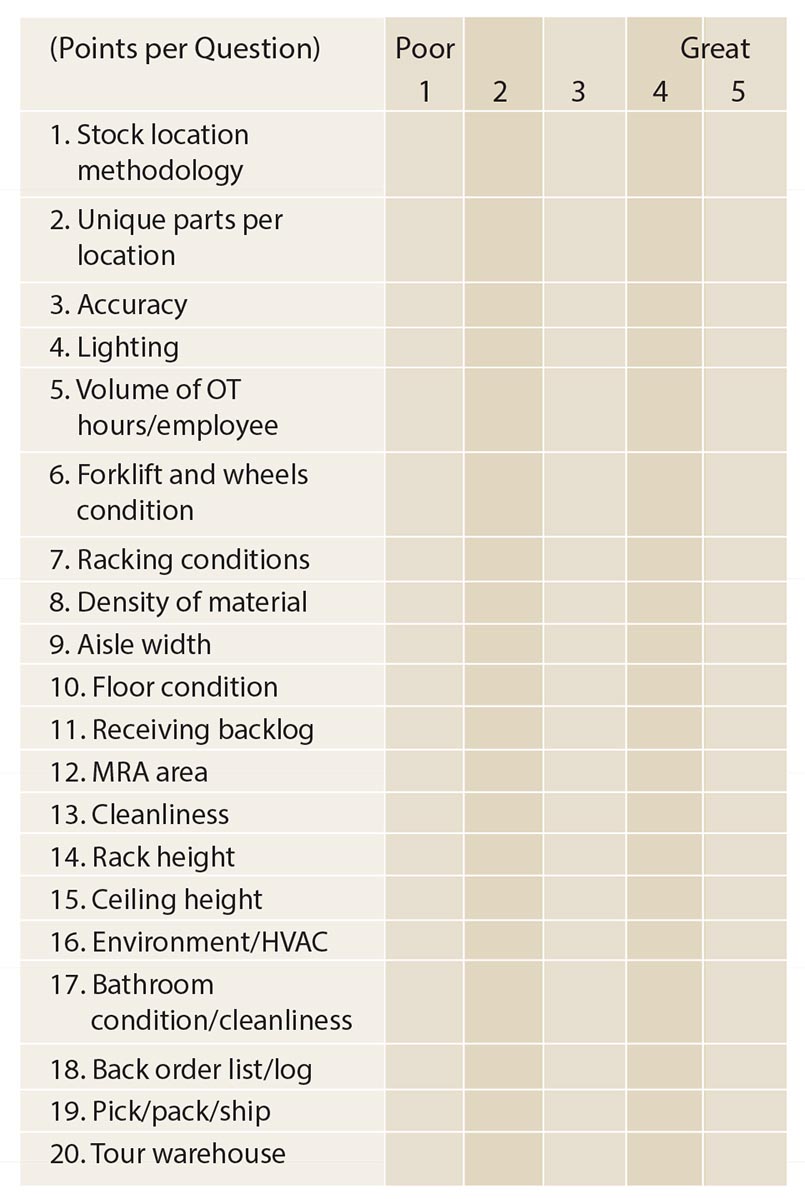Does your Maintenance Repair and Operations (MRO) Warehouse Make the Grade?
Your MRO Warehouse layout and maintenance is a reflection of your company’s attitude about its business. In a pre-award audit of your facility, would prospective customers/clients be favorably impressed, or would you be the cause of the lost business because you’ve got a mess going on? Use this article to calculate your MRO Warehouse grade.
Your MRO DC/warehouse layout and maintenance is a reflection of your company’s attitude about its business. In a pre-award audit of your facility, would prospective customers/clients be favorably impressed, or would you be the cause of the lost business because you’ve got a mess going on?
What would a consultant or a subject matter expert say?
What would they find?
What would they do?
What’s the final grade?
Would you get an “F”?
(Use the table below to calculate your personal grade)
The following is a list of 20 items that should answer those questions and put you on the path for recovery.
- How’s your stock location system? Can you find stuff? You should have absolutely no “overflow” because that isn’t a system.
- How many unique stock keeping units (SKUs) go into one stock location? One. That’s correct. No multiple parts are to be stored in one location, but multiple SKUs on one shelf is OK.
- How’s your inventory record accuracy? What was the result of the last physical inventory or the aggregate of the last 12 months cycle counts? What was the gross result? Not the net results (over 50 units of stock item A and -40 units of stock unit B because that equals a -10). It’s really a gross error of 90 units on two SKUs, which is much more significant overall.
- How’s the lighting? Is it clear and bright, or is it as dark as a dungeon? If it’s not clear and bright, then it is not conducive to error-free and accurate work. This means employees are probably lurking in the shadows making mistakes and aren’t overly concerned about them.
- What’s the current, historic and ongoing “over time” expenditure per warehouse employee? Over time is a common indicator of a major problem.
- What’s the condition of the lift trucks? And, the hard rubber wheels? Nothing does in forklift wheels like the surface of the floor. And don’t even think of taking any forklift outside on an unpaved surface unless it has rubber inflatable tires. Solid rubber wheels cost a fortune (at least $1,000 per wheel) and a lot of time to replace.
- What’s the condition of your racking? Is it bruised, bent, busted, rusted, stable or rickety? Remember that wobbly racks are unsafe and a safety hazard, and corner posts are a must to protect life and safeguard materials. Don’t forget to safeguard pass-through/pass-under racks—lots of veteran warehouse personnel have driven into them with a raised mast.
- How densely packed is your warehouse? Don’t over pack your racks, but under packing is also a problem. On average, a warehouse at 80% capacity is full because space to put up stock is necessary or you begin playing that game of “move this to move that.”
- What is your aisle width? It’s common to walk into warehouses with “dance floor aisles,” that is to say: 13-, 14-, 15-, 16-foot aisles. But, that’s a waste of space. I don’t advocate a “narrow aisles concept” for everyone. In a lot of cases, they’re not practical, but 12-foot aisles certainly are. And, don’t forget training. To go from 16-foot aisles to 12-foot aisles requires retraining.
- What’s the condition of the floor? Is it cluttered? Is it wet or have puddles? Has the floor been gouged out by pushing pallets on the floor? Has it been so used/abused it has ruts, dings or holes in it?
- What’s the receiving backlog? Have things been accumulating and receipt been pushed off or delayed? If you have more than one day worth of materials in receiving, then you’ve got a problem. How can you tell if you have an issue? Simply look at the delivered date on the bill of lading or packing list.
- Is there a formal material reject area (MRA)? If so, is it secure? How large an space does this MRA area take up? If it feels too big, then there’s your first step of the action plan. Who owns the MRA area? How long has the oldest material been sitting there? If it’s more than two weeks, you probably have some issues.
- Overall, how clean is the warehouse? Are the floors swept daily or at the end of every shift? Are there banding strips and stretch wrap plastic lying around all over the place or in a huge pile? How about busted “scab pallets,” chunks of wood, pieces of corrugated strewn around? If yes, this tells you the mindset of the warehouse employees and its supervision. Clean it up!
- What’s your rack height? Are you using all your vertical space? An easy way to add space is to go up.
- What are your ceiling heights and conditions? Do you have sprinklers in place? Does the roof leak?
- What are your warehouse environmental conditions? Don’t forget that not only do people need HVAC to be at optimum conditions, but so does your materials. Rubber, plastics, electronics, chemicals, medical parts may all require environmental protection.
- What are the bathroom conditions in the warehouse area? Poor, dirty, unkempt, unhygienic bathrooms are an indicator of management’s attitude toward its employees and the warehouse in general.
- What is your current back-order system? That is to say: How do you capture the shortages owed? Do you have a log? Do you have a manually maintained list?
- Do you have a formal pick/pack/ship area set aside especially for that function? Where do you store the kits once picked and ready for delivery? Do you deliver or require your customers to come retrieve their own materials?
- Do you personally tour the warehouse looking for safety issues? Do you know how HAZMAT should be stored? Do you realize batteries are classified as hazardous? Do you have secondary containment equipment in place/in use for oil, paint, liquid chemicals, etc.?

In conclusion, remember that optics really do matter. No one may care what a consultant or subject matter expert would think, but do you have “skeletons in the closet” or is the “central nervous center” in good enough shape to be viewed by a customer? In a pre-award audit, would your warehouse/DC win or lose the potential business?
You can use the table below to calculate your final grade.














